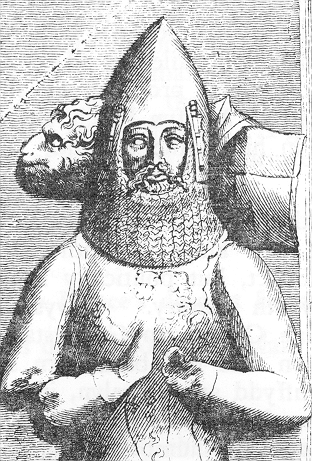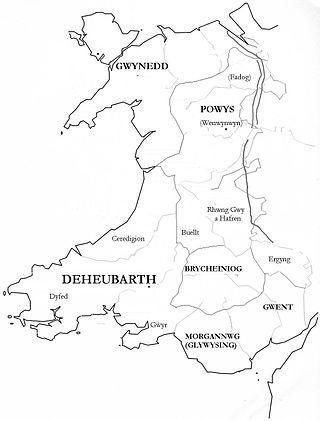
Rhys ap Gruffydd, commonly known as The Lord Rhys, in Welsh Yr Arglwydd Rhys was the ruler of the Welsh kingdom of Deheubarth in south Wales from 1155 to 1197 and native Prince of Wales.

Year 1198 (MCXCVIII) was a common year starting on Thursday of the Julian calendar.

Year 1246 (MCCXLVI) was a common year starting on Monday of the Julian calendar.
Geoffrey was an illegitimate son of King Henry II of England who became bishop-elect of Lincoln and archbishop of York. The identity of his mother is uncertain, but she may have been named Ykenai. Geoffrey held several minor clerical offices before becoming Bishop of Lincoln in 1173, though he was not ordained as a priest until 1189. In 1173–1174, he led a campaign in northern England to help put down a rebellion by his legitimate half-brothers; this campaign led to the capture of William, King of Scots. By 1182, Pope Lucius III had ordered that Geoffrey either resign Lincoln or be consecrated as bishop; he chose to resign and became chancellor instead. He was the only one of Henry II's sons present at the king's death.
Nest ferch Rhys was the daughter of Rhys ap Tewdwr, last King of Deheubarth in Wales, by his wife, Gwladys ferch Rhiwallon ap Cynfyn of Powys. Her family is of the House of Dinefwr. Nest was the wife of Gerald de Windsor, Constable of Pembroke Castle and son of the Constable of Windsor Castle in Berkshire, by whom she was the ancestress of the FitzGerald dynasty.

Robert FitzStephen was a Cambro-Norman soldier, one of the leaders of the Norman invasion of Ireland, for which he was granted extensive lands in Ireland. He was a son of the famous Nest, daughter of Rhys ap Tewdwr, the last king of Deheubarth. His father was Nest's second husband, Stephen, Constable of Cardigan. Following the death of her first husband, Gerald de Windsor, her sons had married her to Stephen, her husband's constable for Cardigan. By Stephen, she had another son, possibly two; the eldest was Robert, and the younger may have been Hywel.

Sir William ap Thomas was a Welsh nobleman, politician, knight, and courtier. He was a member of the Welsh gentry family that came to be known as the Herbert family through his son William Herbert, 1st Earl of Pembroke and is the agnatic ancestor, via an illegitimate descendant of the 1st Earl of the 8th creation, of the current Herbert family of the Earl of Pembroke and Montgomery, and also of the Herbert Earl of Carnarvon.

Abergavenny Castle is a ruined castle in the market town of Abergavenny, Monmouthshire, Wales, established by the Norman lord Hamelin de Balun c. 1087. It was the site of a massacre of Welsh noblemen in 1175, and was attacked during the early 15th-century Glyndŵr Rising. William Camden, the 16th-century antiquary, said that the castle "has been oftner stain'd with the infamy of treachery, than any other castle in Wales."

Gwent was a medieval Welsh kingdom, lying between the Rivers Wye and Usk. It existed from the end of Roman rule in Britain in about the 5th century until the Norman invasion of Wales in the 11th century. Along with its neighbour Glywyssing, it seems to have had a great deal of cultural continuity with the earlier Silures, keeping their own courts and diocese separate from the rest of Wales until their conquest by Gruffydd ap Llywelyn. Although it recovered its independence after his death in 1063, Gwent was the first of the Welsh kingdoms to be overrun following the Norman conquest.
Morgan was a medieval Bishop-elect of Durham.
This article is about the particular significance of the century 1101–1200 to Wales and its people.
Events from the 1240s in England.

The history of Gwynedd in the High Middle Ages is a period in the History of Wales spanning the 11th through the 13th centuries. Gwynedd, located in the north of Wales, eventually became the most dominant of Welsh polities during this period. Contact with continental courts allowed for Gwynedd to transition from a petty kingdom into an increasingly sophisticated principality of seasoned courtiers capable of high level deplomacy and representation; not only with the Angevine kings, but also the king of France and the Papal See. Distinctive achievements in Gwynedd include further development of Medieval Welsh literature, particularly poets known as the Beirdd y Tywysogion associated with the court of Gwynedd; the reformation of bardic schools; and the continued development of Cyfraith Hywel. All three of these further contributed to the development of a Welsh national identity in the face of Anglo-Norman encroachment of Wales.
Isabel de Clare, suo jure 4th Countess of Pembroke and Striguil, was an Anglo-Norman and Irish noblewoman descended from Aoife Macmurrough and Richard de Clare and one of the wealthiest heiresses in Wales and Ireland. She was the wife of William Marshal, 1st Earl of Pembroke, who served three successive kings as Marshal of England. Her marriage had been arranged by King Richard I.
Morgan ap Hywel was Lord of Gwynllwg in Wales from about 1215 until his death in 1245, and for many years laid claim to the lordship of Caerleon, which had been seized by the Earl of Pembroke. For most of his life he was at peace with the English, at a time when there were periodic revolts by Welsh leaders against their rule. He may have participated in a crusade between 1227 and 1231.
Richard of Lincoln was the illegitimate son of Henry I of England, born to Henry and a woman named Ansfride, widow of Aanskill. She is often referred to as Henry’s third mistress. Richard was brought up and educated by Robert Bloet, the Bishop of Lincoln. Bloet had also educated Richard’s half-brother Robert, 1st Earl of Gloucester. Richard is sometimes confused with Richard de Lincoln, an Anglo-Norman prelate who died in 1203.
Owain ap Caradog, known as Owain ‘Wan’ was the son and heir of King Caradog ap Gruffydd of Morgannwg, who contested the Kingdom of Deheubarth and was killed in the Battle of Mynydd Carn in 1081. Owain contented himself by ruling the former sub-kingdom and later Lordship of Gwynllwg, while the title of King of Morgannwg went to his relative Iestyn ap Gwrgant, who was subsequently deposed c. 1090 as part of the Norman conquest of Wales. In spite of this Owain continued to hold onto territories between the Rhymney and Usk, and may, probably with some struggle, have held onto some or all of Caerleon, where in 1086 the Domesday book records that a small colony of eight carucates of land was held by Turstin FitzRolf, standard bearer to William the Conqueror at Hastings, under the overlordship of William d'Ecouis, a magnate with lands in Herefordshire, Norfolk and other counties. Also listed on the manor were three Welshmen with as many ploughs and carucates, who continued their Welsh customs.
Morgan ab Owain was a Welsh king and Lord of Caerleon. He was a son of Owain Wan and thus a grandson of Caradog ap Gruffydd, the last Welsh king of Gwent.
Iorwerth ab Owain was a Welsh prince of Gwynllŵg and Lord of Caerleon.

Hywel ab Iorwerth was a Welsh lord of Caerleon.











